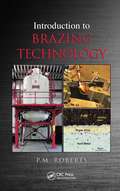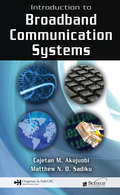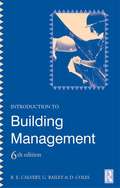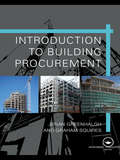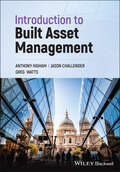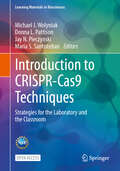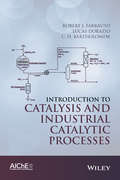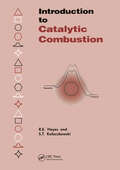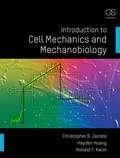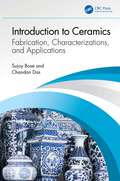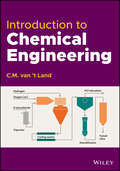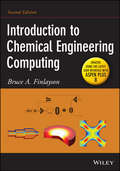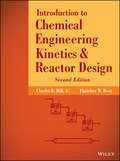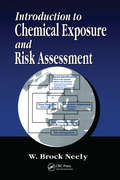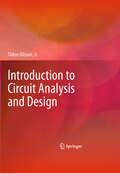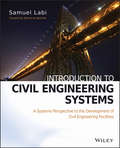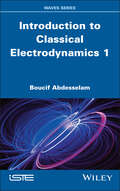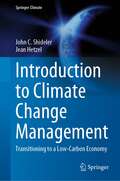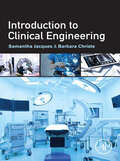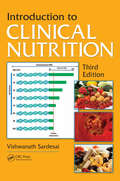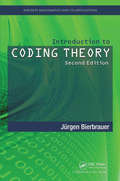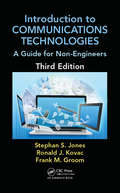- Table View
- List View
Introduction to Brazing Technology
by P.M RobertsIntroduction to Brazing Technology provides practical guidance for the industrial production of an effectively brazed joint. Written in plain language by an active technical consultant with more than 50 years of brazing experience, this clear and concise book:Explains the fundamental concepts of the brazing processCovers all the common heating meth
Introduction to Broadband Communication Systems
by Cajetan M. Akujuobi Matthew N.O. SadikuBroadband networks, such as asynchronous transfer mode (ATM), frame relay, and leased lines, allow us to easily access multimedia services (data, voice, and video) in one package. Exploring why broadband networks are important in modern-day telecommunications, Introduction to Broadband Communication Systems covers the concepts and components of bot
Introduction to Building Management
by D. Coles G. Bailey R E CalvertThis is the classic practical introduction to the broad principles of building management. It is suitable for both students and practising construction professionals who are concerned with greater efficiency within the construction industry. As a general textbook for the student, the introduction covers the entire field in some depth providing a firm foundation for additional reading. The text is closely geared to the chartered Institute of Building (Member) Parts I and II examinations. The book includes examples based upon and related to working experience. It will also be found valuable by students reading for the examinations of other professional bodies in the construction industry, and by HNC/D students.
Introduction to Building Procurement
by Brian Greenhalgh Graham SquiresThe procurement stage of the building process is critical to the success of any building project, and as such must be understood by everybody entering the industry. Introduction to Building Procurement is designed to familiarize the novice with the principles and methods of building procurement, starting at the most basic level. With chapter summaries and tutorial questions provided throughout the book, the reader will get to grips with the following topics: the structure of the construction industry the nature of clients the historical development of building procurement methods the roles and responsibilities carried out in any project. Having developed the necessary background knowledge, the reader is then introduced to the more complex aspects of procurement in detail, such as: methods of paying contractors the main procurement routes in use standard forms of contract. The concluding chapter discusses emerging procurement trends, and speculates on future developments to bring the reader right up to speed with the modern industry. With its clear layout and highly accessible approach, Introduction to Building Procuremen is the perfect introductory text for undergraduate students and professionals starting out on a career in quantity surveying, construction project management or construction commercial management.
Introduction to Built Asset Management
by Anthony Higham Jason Challender Greg WattsIntroduction to Built Asset Management Provides a multidisciplinary introduction to building maintenance management and execution, covering a wide range of current technical and management issues The maintenance and upgrading of existing buildings is no longer viewed as separate from the operational phase of the completed building. Maintenance and management are now regarded as fundamental parts of a building’s life cycle, forming a significant percentage of the construction industry’s total output. As higher education programmes in the UK and elsewhere continue to place greater emphasis on the longer-term view of construction projects, students and instructors require a thorough and up-to-date textbook that emphasises the comprehensive nature of building maintenance. Introduction to Built Asset Management is a systematic introduction to both the technology and management issues central to building maintenance and refurbishment. Covering the entire life cycle of built assets, the textbook reviews the role of framework agreements, describes key performance indicators, discusses recent advancements in the procurement of maintenance activities and more. Detailed yet accessible chapters include illustrative examples, seminar questions and self-assessment tasks that enable students to measure their progress as they work through the material. Designed to meet the needs of today’s learners, this much-needed textbook: Addresses a variety of both environmental and commercial concerns Evaluates important concepts of sustainability, sustainable maintenance and carbon resilience Discusses the growing retrofit market in the wider context of asset management and maintenance Describes information management tools such as building information modelling (BIM) and geographic information systems (GIS) Introduction to Built Asset Management is ideally suited for courses in construction, construction management, building surveying and facilities management with modules in built asset management and maintenance.
Introduction to CRISPR-Cas9 Techniques: Strategies for the Laboratory and the Classroom (Learning Materials in Biosciences)
by Michael J. Wolyniak Donna L. Pattison Jay N. Pieczynski Maria S. SantistebanThis open-access textbook provides an in-depth introduction into the CRISPR-cas9 technology and explores its use across the gamut of biological model systems. As the subject has risen from a significant new discovery to a mainstream molecular biology practice, it is essential that students of molecular biology understand the fundamentals behind CRISPR-Cas9 technology and how it may be employed efficiently and ethically in research. This volume, edited by experts in both, molecular biology and undergraduate education, will teach not only the fundamentals of using CRISPR-Cas9, but also how to successfully employ this technology in classroom settings. The book is written for undergraduates and advanced high school classes in the area of molecular biology, genetics, genomics and biological engineering and will provide a perfect tool for undergraduate lecturers to prepare their classes.
Introduction to Catalysis and Industrial Catalytic Processes
by Robert J. Farrauto Lucas Dorazio C. H. BartholomewIntroduces major catalytic processes including products from the petroleum, chemical, environmental and alternative energy industries Provides an easy to read description of the fundamentals of catalysis and some of the major catalytic industrial processes used today Offers a rationale for process designs based on kinetics and thermodynamics Alternative energy topics include the hydrogen economy, fuels cells, bio catalytic (enzymes) production of ethanol fuel from corn and biodiesel from vegetable oils Problem sets of included with answers available to faculty who use the book Review:"In less than 300 pages, it serves as an excellent introduction to these subjects whether for advanced students or those seeking to learn more about these subjects on their own time...Particularly useful are the succinct summaries throughout the book...excellent detail in the table of contents, a detailed index, key references at the end of each chapter, and challenging classroom questions..." (GlobalCatalysis.com, May 2016)
Introduction to Catalytic Combustion
by R.E. HayesIn a clear and concise manner, this book explains how to apply concepts in chemical reaction engineering and transport phenomena to the design of catalytic combustion systems. Although there are many textbooks on the subject of chemical reaction engineering, catalytic combustion is mentioned either only briefly or not at all. The authors have chosen three examples where catalytic combustion is utilized as a primary combustion process and natural gas is used as a fuel - stationary gas turbines, process fluid heaters, and radiant heaters; these cover much of the area where research is currently most active. In each of these there are clear environmental benefits to be gained illustrating catalytic combustion as a "cleaner primary combustion process" . The dominant heat transfer processes in each of the applications are different, as are the support systems, flow geometrics and operating conditions.
Introduction to Celestial Navigation (Springer Series on Naval Architecture, Marine Engineering, Shipbuilding and Shipping #15)
by Alexander Arnfinn OlsenThis book focuses on Coastal and Ocean Navigation with an emphasis on celestial navigation techniques as a ‘back up’ in the event digital technologies fail.It deals with the main themes and principles of celestial navigation (including time). It covers the syllabus for deck officers working towards the Officer of the Watch (OOW) certificate of competence (COC) awarded by the Maritime and Coastguard Agency (MCA), and for Royal Navy navigation officers working towards achieving the equivalent Navigational Watch Certificate (NWC). The NWC is equivalent to the certificate awarded by the MCA to OOWs in the Merchant Service under the international Standardisation of Training, Certification and Watchkeeping (STCW) agreements. The detailed theory of celestial navigation is provided.
Introduction to Cell Mechanics and Mechanobiology
by Christopher R. Jacobs Hayden Huang Ronald Y. KwonIntroduction to Cell Mechanics and Mechanobiology is designed for a one-semester course in the mechanics of the cell offered to advanced undergraduate and graduate students in biomedical engineering, bioengineering, and mechanical engineering. It teaches a quantitative understanding of the way cells detect, modify, and respond to the physical prope
Introduction to Ceramics: Fabrication, Characterizations, and Applications
by Chandan Das Sujoy BoseThe field of ceramics has applications in diverse fields including electronic engineering, electrical engineering, biochemical engineering, automobile engineering and defense sector. This textbook discusses ceramic raw materials, properties of ceramics, fabrication techniques of ceramics and testing of ceramics. It comprehensively discusses mechanical properties, thermal properties, optical properties, electrical properties and magnetic properties of ceramics. The text covers structural characteristics, properties and applications of advanced ceramic materials and examines their difference from the conventional ceramics. A separate chapter discusses testing methods of ceramics including testing of raw materials, testing of physical properties, testing of mechanical strength and testing of electrical properties in dept. This textbook begins by discussing ceramic raw materials, proceeds with conventional ceramics, continues with properties and fabrication techniques of ceramic materials, testing of ceramics and ends with covering advanced ceramics.This book features: Covers ceramics from traditional to advanced Discusses fabrication, characterization and applications of ceramics in detail Examines mechanical properties, thermal properties, optical properties, electrical properties and magnetic properties of ceramics in detail Covers structural characteristics, properties and applications of carbides, nitrides, oxides and borides Discusses processing techniques including mechanical separation and magnetic separation of ceramics It will help serve as ideal study material for senior undergraduate and graduate students in the field of chemical engineering, materials science and engineering, and ceramic technology.
Introduction to Chemical Engineering
by C. M. van 't LandIntroduction to Chemical Engineering An accessible introduction to chemical engineering for specialists in adjacent fields Chemical engineering plays a vital role in numerous industries, including chemical manufacturing, oil and gas refining and processing, food processing, biofuels, pharmaceutical manufacturing, plastics production and use, and new energy recovery and generation technologies. Many people working in these fields, however, are nonspecialists: management, other kinds of engineers (mechanical, civil, electrical, software, computer, safety, etc.), and scientists of all varieties. Introduction to Chemical Engineering is an ideal resource for those looking to fill the gaps in their education so that they can fully engage with matters relating to chemical engineering. Based on an introductory course designed to assist chemists becoming familiar with aspects of chemical plants, this book examines the fundamentals of chemical processing. The book specifically focuses on transport phenomena, mixing and stirring, chemical reactors, and separation processes. Readers will also find: A hands-on approach to the material with many practical examples Calculus is the only type of advanced mathematics used A wide range of unit operations including distillation, liquid extraction, absorption of gases, membrane separation, crystallization, liquid/solid separation, drying, and gas/solid separation Introduction to Chemical Engineering is a great help for chemists, biologists, physicists, and non-chemical engineers looking to round out their education for the workplace.
Introduction to Chemical Engineering Computing
by Bruce A. FinlaysonStep-by-step instructions enable chemical engineers to master key software programs and solve complex problemsToday, both students and professionals in chemical engineering must solve increasingly complex problems dealing with refineries, fuel cells, microreactors, and pharmaceutical plants, to name a few. With this book as their guide, readers learn to solve these problems using their computers and Excel, MATLAB, Aspen Plus, and COMSOL Multiphysics. Moreover, they learn how to check their solutions and validate their results to make sure they have solved the problems correctly.Now in its Second Edition, Introduction to Chemical Engineering Computing is based on the author's firsthand teaching experience. As a result, the emphasis is on problem solving. Simple introductions help readers become conversant with each program and then tackle a broad range of problems in chemical engineering, including:Equations of stateChemical reaction equilibriaMass balances with recycle streamsThermodynamics and simulation of mass transfer equipmentProcess simulationFluid flow in two and three dimensionsAll the chapters contain clear instructions, figures, and examples to guide readers through all the programs and types of chemical engineering problems. Problems at the end of each chapter, ranging from simple to difficult, allow readers to gradually build their skills, whether they solve the problems themselves or in teams. In addition, the book's accompanying website lists the core principles learned from each problem, both from a chemical engineering and a computational perspective.Covering a broad range of disciplines and problems within chemical engineering, Introduction to Chemical Engineering Computing is recommended for both undergraduate and graduate students as well as practicing engineers who want to know how to choose the right computer software program and tackle almost any chemical engineering problem.
Introduction to Chemical Engineering Kinetics and Reactor Design
by Charles G. Hill Thatcher W. RootThe Second Edition features new problems that engage readers in contemporary reactor designHighly praised by instructors, students, and chemical engineers, Introduction to Chemical Engineering Kinetics & Reactor Design has been extensively revised and updated in this Second Edition. The text continues to offer a solid background in chemical reaction kinetics as well as in material and energy balances, preparing readers with the foundation necessary for success in the design of chemical reactors. Moreover, it reflects not only the basic engineering science, but also the mathematical tools used by today's engineers to solve problems associated with the design of chemical reactors.Introduction to Chemical Engineering Kinetics & Reactor Design enables readers to progressively build their knowledge and skills by applying the laws of conservation of mass and energy to increasingly more difficult challenges in reactor design. The first one-third of the text emphasizes general principles of chemical reaction kinetics, setting the stage for the subsequent treatment of reactors intended to carry out homogeneous reactions, heterogeneous catalytic reactions, and biochemical transformations. Topics include:Thermodynamics of chemical reactionsDetermination of reaction rate expressionsElements of heterogeneous catalysisBasic concepts in reactor design and ideal reactor modelsTemperature and energy effects in chemical reactorsBasic and applied aspects of biochemical transformations and bioreactorsAbout 70% of the problems in this Second Edition are new. These problems, frequently based on articles culled from the research literature, help readers develop a solid understanding of the material. Many of these new problems also offer readers opportunities to use current software applications such as Mathcad and MATLAB®.By enabling readers to progressively build and apply their knowledge, the Second Edition of Introduction to Chemical Engineering Kinetics & Reactor Design remains a premier text for students in chemical engineering and a valuable resource for practicing engineers.
Introduction to Chemical Engineering: For Chemical Engineers and Students
by Uche P. NnajiThe field of chemical engineering is undergoing a global “renaissance,” with new processes, equipment, and sources changing literally every day. It is a dynamic, important area of study and the basis for some of the most lucrative and integral fields of science. Introduction to Chemical Engineering offers a comprehensive overview of the concept, principles and applications of chemical engineering. It explains the distinct chemical engineering knowledge which gave rise to a general-purpose technology and broadest engineering field. The book serves as a conduit between college education and the real-world chemical engineering practice. It answers many questions students and young engineers often ask which include: How is what I studied in the classroom being applied in the industrial setting? What steps do I need to take to become a professional chemical engineer? What are the career diversities in chemical engineering and the engineering knowledge required? How is chemical engineering design done in real-world? What are the chemical engineering computer tools and their applications? What are the prospects, present and future challenges of chemical engineering? And so on. It also provides the information new chemical engineering hires would need to excel and cross the critical novice engineer stage of their career. It is expected that this book will enhance students understanding and performance in the field and the development of the profession worldwide. Whether a new-hire engineer or a veteran in the field, this is a must—have volume for any chemical engineer’s library.
Introduction to Chemical Exposure and Risk Assessment
by W.Brock NeelyIntroduction to Chemical Exposure and Risk Assessment focuses on the principles involved in assessing the risks from chemical exposure. These principles include the perception of risk, an understanding of how numbers are handled, and how chemicals affect health. The book briefly describes the major sinks, such as water and air, where chemicals are introduced. This is followed by a discussion on how concentrations are estimated and risk assessments are made. A discussion of risk benefit analysis and a presentation of several case studies using the principles for assessing risks are also included.
Introduction to Circuit Analysis and Design
by Tildon H. GlissonIntroduction to Circuit Analysis and Design takes the view that circuits have inputs and outputs, and that relations between inputs and outputs and the terminal characteristics of circuits at input and output ports are all-important in analysis and design. Two-port models, input resistance, output impedance, gain, loading effects, and frequency response are treated in more depth than is traditional. Due attention to these topics is essential preparation for design, provides useful preparation for subsequent courses in electronic devices and circuits, and eases the transition from circuits to systems.
Introduction to Civil Engineering Systems
by Samuel LabiThis book presents an integrated systems approach to the evaluation, analysis, design, and maintenance of civil engineering systems. Addressing recent concerns about the world's aging civil infrastructure and its environmental impact, the author makes the case for why any civil infrastructure should be seen as part of a larger whole. He walks readers through all phases of a civil project, from feasibility assessment to construction to operations, explaining how to evaluate tasks and challenges at each phase using a holistic approach. Unique coverage of ethics, legal issues, and management is also included.
Introduction to Classical Electrodynamics, Volume 1 (ISTE Invoiced)
by Boucif AbdesselamIntroduction to Classical Electrodynamics 1 introduces the fundamentals of electromagnetic field theory. This book begins with electrostatics, focusing on the concepts of point charges, electric fields, electric potential and Gauss’s theorem. It then examines conductors, influence phenomena and capacitors, before exploring electrokinetics, detailing the concepts of electric current, circuits and resistance, as well as Kirchhoff’s laws. Next, this book analyzes the notion of magnetic field, Lorentz and Laplace forces, Biot-Savart’s law, Ampère’s theorem, electric and magnetic moments, and multipole developments. Boundary problems for static potentials in vacuum are also studied. The book is aimed at students of physics and mathematics, as well as engineering students interested in electromagnetic theory, providing an overview of electromagnetic theory, with numerous practical applications.
Introduction to Climate Change Management: Transitioning to a Low-Carbon Economy (Springer Climate)
by John C. Shideler Jean HetzelThis book provides climate students with the basic scientific background to climate change management. Students will learn about international and national approaches to climate change management defined in voluntary initiatives as well as in national law and international agreements. The book describes mitigation and adaptation measures, monitoring and reporting of greenhouse gas emissions, and strategies for achieving a low-carbon economy, including green finance.This book combines theory and practice, introducing students to the conceptual background but also taking a professional and technical approach with case studies and low carbon toolkits. Filled with didactic elements such as concept schemes, tables, charts, figures, examples, as well as questions and answers at the end of the chapters, this book aims to engage critical thinking and the discussion of important topics of our days.The low-carbon strategy is one of the answers to limiting the greenhouse effect on our planet. This strategy is to minimize the overall carbon consumption in the life cycle of the products we consume, from the extraction of raw materials to the end of their life. The future is being built today. This book will guide its readers along the path of imagining and realizing a low-carbon economy.”
Introduction to Clinical Engineering
by Barbara Christe PhD Samantha Jacques FacheIntroduction to Clinical Engineering focuses on the application of engineering practice within the healthcare delivery system, often defined as clinical engineering. Readers will explore the fundamental concepts integral to the support of healthcare technology to advance medical care. The primary mission of clinical engineers is the utilization of medical devices, software, and systems to deliver safe and effective patient care throughout technology’s lifecycle. This unique and interdisciplinary workforce is part of the healthcare team and serves as the intersection between engineering and medicine. <P> This book is aimed at practitioners, managers, students, and educators to serve as a resource that offers a broad perspective of the applications of engineering principles, regulatory compliance, lifecycle planning, systems thinking, risk analysis, and resource management in healthcare. This book is an invaluable tool for healthcare technology management (HTM) professionals and can serve as a guide for students to explore the profession in depth. <P> Offers readers an in-depth look into the support and implementation of existing medical technology used for patient care in a clinical setting <BR> Provides insights into the clinical engineering profession, focusing on engineering principles as applied to the US healthcare system <BR> Explores healthcare technology, hospital and systems safety, information technology and interoperability with medical devices, clinical facilities management, as well as human resource management
Introduction to Clinical Nutrition
by Vishwanath SardesaiDietary factors have been implicated in at least four of the ten leading causes of death in the U.S. (heart disease, cancer, diabetes, and stroke). Nevertheless, physicians frequently receive inadequate training in nutrition to properly counsel their patients. Introduction to Clinical Nutrition, Third Edition discusses the physiologic and metabolic
Introduction to Coding Theory (Discrete Mathematics and Its Applications)
by Jurgen BierbrauerThis book is designed to be usable as a textbook for an undergraduate course or for an advanced graduate course in coding theory as well as a reference for researchers in discrete mathematics, engineering and theoretical computer science. This second edition has three parts: an elementary introduction to coding, theory and applications of codes, and algebraic curves. The latter part presents a brief introduction to the theory of algebraic curves and its most important applications to coding theory.
Introduction to Communication Systems
by Upamanyu MadhowShowcasing the essential principles behind modern communication systems, this accessible undergraduate textbook provides a solid introduction to the foundations of communication theory. Carefully selected topics introduce students to the most important and fundamental concepts, giving students a focused, in-depth understanding of core material, and preparing them for more advanced study. Abstract concepts are introduced to students 'just in time' and reinforced by nearly 200 end-of-chapter exercises, alongside numerous MATLAB code fragments, software problems and practical lab exercises, firmly linking the underlying theory to real-world problems, and providing additional hands-on experience. Finally, an accessible lecture-style organisation makes it easy for students to navigate to key passages, and quickly identify the most relevant material. Containing material suitable for a one- or two-semester course, and accompanied online by a password-protected solutions manual and supporting instructor resources, this is the perfect introductory textbook for undergraduate students studying electrical and computer engineering.
Introduction to Communications Technologies: A Guide for Non-Engineers, Third Edition
by Stephan Jones Ronald J. Kovac Frank M. GroomThanks to the advancement of faster processors within communication devices, there has been a rapid change in how information is modulated, multiplexed, managed, and moved. While formulas and functions are critical in creating the granular components and operations of individual technologies, understanding the applications and their purposes in the
